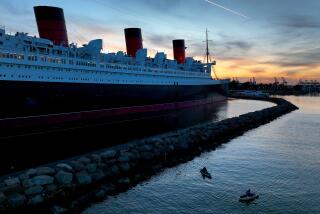Pilgrim’s Progress
- Share via
DANA POINT — All around the deck, beneath the sea gulls and gliding hawks, Janet Cherpes had no trouble finding things to fix.
Using a wire brush, she scraped rust from the bow. She also tarred some of the standing rigging to protect it from the saltwater and the searing sun.
“This is my day, my time,” said the strong and lean 37-year-old management recruiter with tar marks on her hands and jeans. “It’s always the best day of my week and I may scrape all day.”
Cherpes, from Long Beach, is one of the few women in a small group of dedicated volunteers who are tied to this potent symbol of the past. And every Saturday, about a dozen of them gather to maintain the object of their devotion, a 130-foot tall ship called the Pilgrim.
It is a replica of the vessel that 163 years ago carried famed novelist Richard Henry Dana to what is now Dana Point. Now, the ship needs repair, and the volunteers are ready. Whether it’s to fix the engine, tar the rigging or paint a mast, the sailors are there, bonded to another place and time.
They share many reasons for keeping the Pilgrim shipshape. But it mainly comes down to this: sailing it.
“It’s not every day you get to go sailing on a tall ship,” said Doug Corey, a sailing master who was part of the original crew of volunteers in 1985.
For the Orange County Maritime Institute, which owns the 53-year-old ship, the volunteers are critical to keeping the past afloat.
“There is no way we could operate this ship without the volunteer effort,” said Daniel T. Stetson, director of maritime affairs for the institute.
On a sunny and breezy Saturday morning, 18 volunteers showed up at Dana Point Harbor, eager to prepare the Pilgrim for its next voyage. It was on the original Pilgrim that author Dana traveled from Boston to California to procure cow hides for the New England leather trade, a journey he documented in the novel “Two Years Before the Mast.”
Soon one sailor, prying with a marlin spike, discovered rotting wood in a mast. They removed its sail and rolled the heavy canvas like a carpet. Then six men hoisted it on their shoulders and carried it off to the nearby spar yard, where several masts were being painted.
There, Sandy Fredsti was varnishing a 110-foot wooden mast. Fredsti, 82, is the oldest volunteer and drives over with his teenage granddaughter.
“I come 80 miles every Saturday. The boat attracts me,” said the La Crescentia resident, wearing a beige hat.
Back on the ship’s deck, Jim Murphy was applying sealant around the corners of the hatchways to keep out water. Bent on his knees, the mechanical engineer said he had done this around the bathtub at home, but he never thought he would do it on a tall ship.
“This is just to keep the guys dry down below,” said Murphy, 56.
Jerry Hochheiser, who credits his work on the Pilrim with keeping him in shape, repaired a mast rope.
“This is part of my physical fitness. You climb up and down that mast a dozen times, you know you had a good workout,” Hochheiser said.
The Laguna Hills retiree has been on ships since World War II.
“Wooden ships are constantly in need of repair,” said Hochheiser, 72, toting a tool belt. “It’s a matter of going over the ship and tracking item by item.”
Below deck, chief engineer John Ross, 50, was supervising work on the diesel engine. Volunteers were installing a trigger valve necessary to start it, which they hope to do within the next month. When several gears broke last year, Ross learned it would be cheaper to buy a similar used engine in Denmark, where the Pilgrim was built, and use it for spare parts than to buy new equipment.
In October, Ross and Corey traveled to Denmark and negotiated the engine purchase. The 6-ton engine, which is the size of a large pick-up truck, reached San Juan Capistrano in January. The institute spent nearly $20,000 on engine-related expenses, Stetson said.
“When it’s running and warm, you can confuse it for being alive,” Ross said of the engine.
Ross said he doesn’t mind donating his time to fix the engine. Still, the Capistrano Beach resident admits “it’s strange why somebody would give so much of their time to this.”
Though the original Pilgrim, which burned at sea in 1856, lacked an engine, the replica relies heavily on mechanized power.
“Purists think it’s just sailing,” said Ross, but he explained that the engineers are responsible for keeping the ship on schedule during its journeys to various ports in California and Mexico. Throughout the year, the Pilgrim also sponsors overnight programs for schoolchildren.
Before they could call it a day, the sailors had one last grueling task at hand. They needed to carry the ship’s tallest mast to the spar yard to continue scraping it for rotting wood. As 11 volunteers readied to lift the 600-pound mast, one reminded, “Use your legs, not your backs.”
Families with young children and people walking their dogs gawked as the sailors lifted the mast onto their shoulders. Grunts followed as they filed by.
In the spar yard, the lifting job finished, several men held onto the fence, gasping for breath.
“A lot of people realize how hard it is, and the romance goes out pretty quick,” Corey said. “Not many people are willing to put in that kind of a commitment.”
People interested in becoming volunteers may visit the Pilgrim on Saturday at 9 a.m. Information: (714) 496-2274, Ext. 210.
More to Read
Sign up for The Wild
We’ll help you find the best places to hike, bike and run, as well as the perfect silent spots for meditation and yoga.
You may occasionally receive promotional content from the Los Angeles Times.






